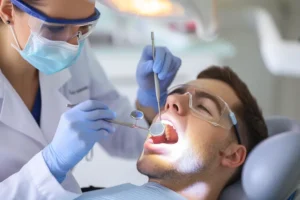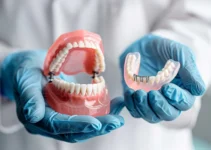A dentoalveolar abscess, commonly referred to as a dental abscess, is an infection at the root of a tooth or between the gum and a tooth. It primarily results from severe tooth decay, periodontal disease, or a break or crack in the tooth that allows bacteria to enter the pulp. The condition is characterized by severe pain, swelling, redness, and the presence of pus. If left untreated, it can lead to more serious infections spreading to other parts of the body. Prompt dental intervention is crucial to treat the infection and possibly save the affected tooth. This article will explore the causes, symptoms, and effective management strategies for dentoalveolar abscesses.
Understanding Dentoalveolar Abscess
A dentoalveolar abscess is a localized collection of pus in the structures surrounding a tooth, typically caused by a bacterial infection. These abscesses are often painful and can lead to severe complications if left untreated. Understanding the mechanisms, types, and symptoms of dentoalveolar abscesses is crucial for effective diagnosis and treatment.
Dentoalveolar abscesses can affect individuals of all ages, and their incidence is influenced by factors such as poor oral hygiene, untreated dental cavities, and weakened immune systems. Early detection and intervention are essential to prevent the spread of infection and to maintain oral health. This section will provide a comprehensive overview of dentoalveolar abscesses, including their definition, types, and the common symptoms and signs to watch out for.
Definition of a Dentoalveolar Abscess
A dentoalveolar abscess, also known as a tooth abscess or periapical abscess, is an infection that leads to the accumulation of pus at the root of a tooth or in the surrounding tissue. The infection typically arises when bacteria invade the dental pulp through a cavity, crack, or periodontal pocket. The body’s immune response sends white blood cells to the site of infection, leading to the formation of pus.
The abscess creates an enclosed space where pressure builds, causing pain and discomfort. If not drained or treated, the infection can spread to nearby tissues and even enter the bloodstream, leading to systemic complications. Prompt dental intervention is crucial to prevent such outcomes and to relieve pain.
Types of Dentoalveolar Abscesses
There are several types of dentoalveolar abscesses, classified based on their location and origin. Understanding these types can help in tailoring the treatment approach to each specific case. The main types include:
- Periapical Abscess: This type occurs at the tip of the tooth’s root and usually results from an untreated dental cavity or trauma that allows bacteria to enter the pulp.
- Periodontal Abscess: Found in the gum tissue adjacent to the tooth, this abscess typically arises due to gum disease or injury that leads to the formation of deep gum pockets.
- Gingival Abscess: This is localized in the gum tissue and not directly associated with the tooth or supporting bone. It may result from foreign objects being trapped in the gums.
The treatment and prognosis for each type of abscess may vary, necessitating a thorough examination and appropriate diagnostic tools to identify the specific kind of abscess present.
Symptoms and Signs
The symptoms of a dentoalveolar abscess can range from mild to severe, and recognizing them early can significantly improve treatment outcomes. Common symptoms include:
- Severe Toothache: Persistent, throbbing pain that can radiate to the jaw, neck, or ear.
- Sensitivity to Hot or Cold: Exaggerated response to temperature changes, even when the stimuli are mild.
- Swelling: Noticeable swelling in the face, cheek, or neck, often accompanied by redness.
- Fever: Elevated body temperature as the body responds to the infection.
- Bad Breath: Foul smell due to the presence of pus and bacterial activity.
In addition to these symptoms, a patient may experience difficulty swallowing, opening their mouth, or general malaise. Diagnosing a dentoalveolar abscess involves clinical examination, radiographic imaging, and occasionally, laboratory tests to identify the causative bacteria. Early identification and management are pivotal in preventing complications and ensuring effective treatment.
To learn more about dental health and other related topics, be sure to explore our vast library of articles.
Causes of Dentoalveolar Abscess
A dentoalveolar abscess is a localized collection of pus in the alveolar bone at the root of a tooth, usually caused by bacterial infection. Understanding the primary causes can help in the prevention and early treatment of this painful condition. The main causes include bacterial infections, dental decay, and trauma.
Recognizing the symptoms and understanding the causes can significantly reduce the risk of severe complications. Knowledge about these factors is crucial for both dental professionals and patients.
Bacterial Infections
Bacterial infections are the most common cause of dentoalveolar abscesses. Harmful bacteria can invade the dental pulp—the innermost part of the tooth containing nerves and blood vessels—through a cavity, crack, or chip in the tooth. Once inside, these bacteria spread and multiply, leading to infection and the formation of pus.
The bacteria involved are usually part of the normal flora of the mouth, such as Streptococcus and Staphylococcus species. These organisms can become pathogenic when they gain access to the inner structures of the tooth.
Preventative measures include maintaining good oral hygiene, such as regular brushing and flossing, and scheduling routine dental check-ups. Such practices can help reduce the likelihood of bacterial infections leading to an abscess.
Dental Decay and Trauma
Dental decay is another leading cause of dentoalveolar abscess. When a tooth decays, the enamel and dentin break down, creating an opening for bacteria to enter the pulp. If left untreated, this decay can progress and lead to an abscess.
Dental trauma, which includes chipped or broken teeth, can also expose the pulp to bacteria. A seemingly minor injury can sometimes lead to severe complications if not promptly addressed. Traumatic injuries can occur from accidents, falls, or sports activities. Using a mouthguard during sports and avoiding chewing on hard objects can help prevent such injuries.
In addition, an untreated trauma can lead to pulpitis, an inflammation of the dental pulp, which can further progress to a full-blown abscess. Regular dental evaluations can identify and treat such issues early, preventing the formation of an abscess.
Understanding the main causes of dentoalveolar abscess is essential for prevention and early intervention. Stay informed and read other articles for more detailed insights into dental health and treatment options.
Risk Factors for Dentoalveolar Abscess
A dentoalveolar abscess is a localized collection of pus associated with a tooth. Several risk factors can predispose an individual to developing a dentoalveolar abscess. Understanding these risk factors is crucial for prevention and maintaining overall oral health.
In this section, we will explore some of the primary risk factors that can lead to the formation of a dentoalveolar abscess, including poor oral hygiene and underlying health conditions. Recognizing these factors can help in implementing preventive measures and seeking timely treatment.
Poor Oral Hygiene
One of the most significant risk factors for developing a dentoalveolar abscess is poor oral hygiene. Regular brushing and flossing are essential for removing food particles and plaque, which can otherwise lead to tooth decay and gum disease. When oral hygiene is neglected, bacteria can accumulate, penetrate the tooth’s protective layers, and reach the pulp, causing infection and eventually an abscess. Additionally, lack of routine dental check-ups can exacerbate the issue. Dentists can identify early signs of tooth decay or gum disease and take preventive measures before these problems escalate into more serious conditions like abscesses. Routine professional cleanings also help in removing tartar build-up that cannot be removed by regular brushing and flossing.
Here are some key practices to maintain good oral hygiene and reduce the risk of abscesses:
- Brush twice a day with fluoride toothpaste.
- Floss daily to remove plaque from areas your toothbrush can’t reach.
- Use an antiseptic mouthwash to reduce bacteria.
- Visit your dentist for regular check-ups and cleanings.
Underlying Health Conditions
Certain underlying health conditions can also increase the risk of developing a dentoalveolar abscess. Conditions that compromise the immune system, such as diabetes, HIV/AIDS, or undergoing chemotherapy, can make it more challenging for the body to fight off infections, including those in the oral cavity. This can lead to more frequent and severe dental infections.
Moreover, conditions like dry mouth (xerostomia), often caused by medications or systemic diseases, can reduce saliva production. Saliva plays a crucial role in neutralizing acids produced by bacteria and washing away food particles. Reduced saliva can therefore contribute to a higher risk of tooth decay and subsequent abscess formation.
Ensuring the management of these underlying health conditions is essential for oral health. For individuals with systemic health issues, collaborating with both medical doctors and dental professionals can help create a comprehensive care plan that addresses both general and oral health needs.
Here are some measures to mitigate the impact of underlying health conditions on oral health:
- Maintain good control of systemic conditions such as diabetes through medication and lifestyle changes.
- Stay hydrated and consider saliva substitutes if experiencing dry mouth.
- Inform your dentist about all medications you are taking.
- Follow a diet that supports both oral and overall health, avoiding excessive sugar and acidic foods.
Understanding and addressing these risk factors are vital steps toward preventing dentoalveolar abscesses. For more detailed information on related topics, feel free to explore our other articles. Staying informed is the first step to maintaining excellent oral health.
Management and Treatment Strategies
The management and treatment of dental issues, particularly those requiring implantology and bone regeneration, require a multidisciplinary approach. Understanding the various treatment strategies and methods available is crucial for achieving successful outcomes. These strategies can be grouped into medical and dental interventions, effective home care and maintenance routines, and prevention methods to curtail further complications.
Each of these approaches is supported by extensive research and clinical practices that aim to restore dental health and functionality. It is essential to comprehend the nuances of these strategies to provide patient-centric care that is both evidence-based and effective. Proper management not only ensures the physical restoration of teeth but also enhances the patient’s overall well-being.
Medical and Dental Interventions
Medical and dental interventions form the cornerstone of managing dental issues requiring complex treatments like dental implants and bone regeneration. These interventions typically involve a combination of surgical procedures, pharmacological treatments, and continuous monitoring to ensure optimal healing and integration of implants.
Key medical and dental interventions include:
- Surgical Placement: The precise placement of dental implants is critical for successful osseointegration. Advanced imaging techniques and meticulous surgical planning are employed to ensure the implant is positioned correctly.
- Bone Grafting: In cases of significant bone loss, bone grafting procedures are performed to regenerate and strengthen the jawbone. This may involve the use of autografts, allografts, or synthetic materials.
- Pharmacological Support: Medications such as antibiotics and pain relievers are prescribed to manage infection risks and provide post-operative comfort.
These interventions are tailored to each patient’s unique clinical situation, taking into account factors such as bone density, overall health, and specific oral health needs.
Home Care and Maintenance
Effective home care and maintenance are vital components in the long-term success of dental implants and bone regeneration treatments. Proper oral hygiene practices help to prevent infections and ensure the longevity of the implants.
Patients are advised to follow these home care routines:
- Regular Brushing and Flossing: Using a soft-bristled toothbrush and non-abrasive toothpaste, patients should brush at least twice daily and floss once a day to remove plaque and food particles.
- Mouth Rinses: Antibacterial mouth rinses can help reduce the bacterial load in the mouth, minimizing the risk of peri-implantitis.
- Avoiding Harmful Habits: Patients should avoid smoking, excessive alcohol consumption, and grinding teeth, as these can compromise the integrity of the implants.
Regular dental check-ups and professional cleanings are also recommended to monitor the health of the implants and surrounding tissues, ensuring prompt intervention if any issues arise.
Prevention Methods
Prevention methods play a crucial role in minimizing the need for extensive dental interventions. Educating patients on the importance of maintaining oral health can significantly reduce the incidence of conditions that necessitate implantology and bone regeneration.
Effective prevention methods include:
- Dietary Choices: Encouraging a balanced diet rich in vitamins and minerals supports bone health and overall oral hygiene.
- Regular Dental Visits: Routine dental check-ups allow for early detection and management of potential issues, preventing them from escalating into more severe problems.
- Proper Oral Hygiene Education: Teaching patients the correct brushing and flossing techniques can help them maintain optimal oral health on a daily basis.
Preventive measures not only enhance the effectiveness of treatment strategies but also contribute to the overall well-being and quality of life of patients.
In conclusion, understanding and implementing a comprehensive approach to management and treatment, including medical and dental interventions, home care and maintenance, and prevention methods, is essential for the successful outcome of dental treatments. For more in-depth insights into these topics, explore our other articles that delve into the specifics of each strategy.
Frequently Asked Questions About Dentoalveolar Abscess
If you are curious or concerned about dentoalveolar abscesses, here are some commonly asked questions and answers that can help you understand more about this dental condition.
What is a dentoalveolar abscess and how is it treated?
A dentoalveolar abscess is an infection that forms in the dental alveolus, where the tooth connects to the jaw, leading to pus accumulation and tissue inflammation. Treatment typically involves draining the abscess, eradicating the infection with antibiotics, and addressing the root cause, often through dental procedures such as root canal treatment or tooth extraction if necessary.

My name is Salman Kapa, a 73-year-old expert in bone regeneration and dental implantology. With decades of experience in the field, I am dedicated to advancing our understanding of oral health and hygiene. Through my research and writing, I aim to contribute to the development of innovative solutions in dental care.




